It is clear that the Battle of England, a fight in the air that was unprecedented, marked the final death knell for the aspirations of the Third Reich. The loss of aircraft and the limited production of new aircraft due to the many strategic bombings of the Allies, resulted in an Allied force majeure in the air. At the most crucial moments in the battle on land, the deployment of the Allied Air Force decided the battle. In the beginning, the German Luftwaffe could still offer sufficient resistance, but in the course of time that resistance became less and less with as one of the last achievements of the Bomber Command, the total unnecessary bombing of Dresden on February 15, 1945, without any resistance from the Luftwaffe.
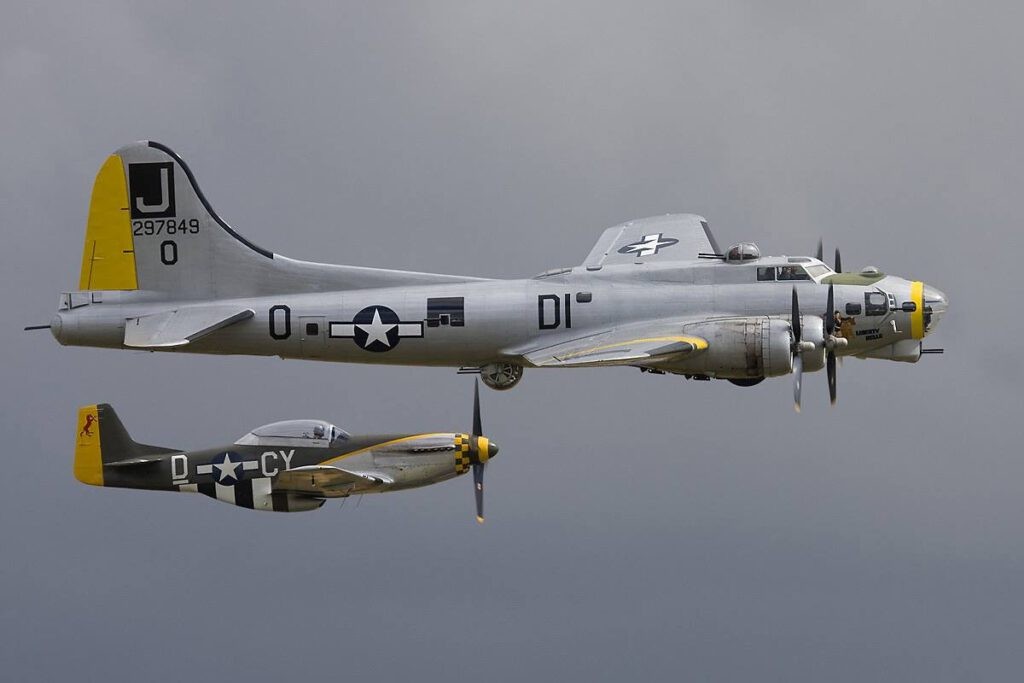
Although there is little knowledge about WWII, the Flying Fortress is a well-known name. The aircraft were stationed at various airports in the UK. If “Bomber Harris” (Arthur Harris, leader of the Bomber Command) issued a new order, then a large number of aircraft departed from all those different airfields. The gathering place was a place above the North Sea, known as “Picadilly Circus”. Collecting all those B-17s and other bombers was a tricky task, especially in less weather. With regularity, planes flew against each other or had to return due to poor visibility. More about that in the article about the bombing of Nijmegen on February 22, 1944, the story of one of the most chaotic bombing flights from the Second World War.
First, some facts:
Number of built: 12,731, divided into 7 variants, the first delivered in January 1939 and used until 1963.
Number of crew members: 10, consisting of a pilot, co-pilot, bomber/front shooter, on-board engineer/back shooter, navigator/radio operator, 2 on-board shooters, the front shooter and a tail shooter. The function of on-board engineer/back shooter was later split over 2 men.
Variants:

B-17A – original version
B-17B – hydraulic brakes, crew repositioning, supercharger on the engines, adjusted directional rudder and flaps
B-17C – Better protection, self-sealing fuel tanks, other guns and setups
B-17D – Crew from 9 to 10, revised cockpit and nose
B-17E – Longer hull, larger stirring, gun dome in the tail and modified other domes
B-17F – Nose from 1 piece perspex, changed shooting setups
B-17G – Dome on the bottom, all domes equipped with Browning .50 machine guns Length/height and span: 22.7/5,8 and 31.6 meters
Kerb weight 16,390 kg, maximum weight 32.660 kg
Engines: 4 x Wright R-1820-97 Cyclone radial, each good for 900 kw
topspeed: 462 km per hour
Range 2980 km
Goal: to eliminate the war industry in Germany
Initially, a fleet of B-17s was sent out alone, without the guidance of fighter planes. Despite the strong armament of the B-17, the aircraft were mostly “sitting ducks” for the German fighter planes. In an attack on 14 October 1943 (Black Thursday) of 291 B-17s, only 33 aircraft returned undamaged (59 downed, 18 emergency landings, 12 aircraft had to be demolished). Of the 2900 crew members, 650 did not return.
In an attack on Schweinfurt in February 1944, 235 B-17s were first accompanied by 2 squadrons P-51 Mustangs and P-47 Thunderbolts. With the changed strategy, “only” 11 B-17s were lost.
So much for the facts. Now a few “live” reports. First a fairly “normal” story of Lt. Hallock (front shooter) and his colleagues about a “day at the office ” in a B-17:
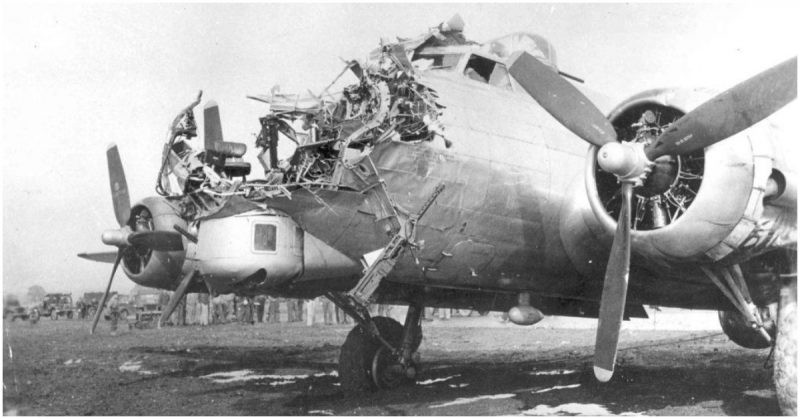
We had at the start of the mission on Augsburg already the idea that it would not be a normal day. After the bombs and on the way home we ended up in a giant “dogfight” with two hundred German fighter planes. Our B-17 group leader had already been brought down and suddenly a 20mm grenade exploded in the nose of our B-17. The grenade splintered the plexiglass of the nose and destroyed the radio equipment. I scribbled to the back of the plane to see if anyone from the crew needed help. Two grenades had damaged the center of the plane. One on-board shooter had been hit in the forehead and the other in his carotid artery. I pressed my finger on the carotid artery, connected it to pressure bandage and gave him a morphine injection. Then I took care of the other gunman’s wound. We didn’t have plasma on board, so there was not much else to do. The tail gunner had heard from the lack of communication that my head had been blown off and he wanted to jump. But the pilot had assured him that I was only hurt. Then I crawled back forward, took care of my own wounds. I was then ready to operate my machine gun again. The German fighter planes hunted us for three quarters of an hour. They came so close that I could see the pilot’s face. By that time we had fallen back from the group, but the Germans had more or less disappeared. The question now was whether we could still come home. The plane was quite damaged and the oxygen system was totally on patches. The choice was now either to return home or to fly to Switzerland. The first option almost impossible, the second quite simple. I was busy handing out oxygen bottles. I would have gone for Switzerland, but the rest of the crew chose England. After a while we were almost without oxygen and we had to drop to 1000 feet, dangerously low. We saw 4 fighter planes in front of us, but luckily that turned out to be 4 P-47s. They accompanied us until we were back in England. “Thanks God for what you have done for us today. “
This story can be considered “quite normal.” The three following reports are of the outside category.
Piggyback flight
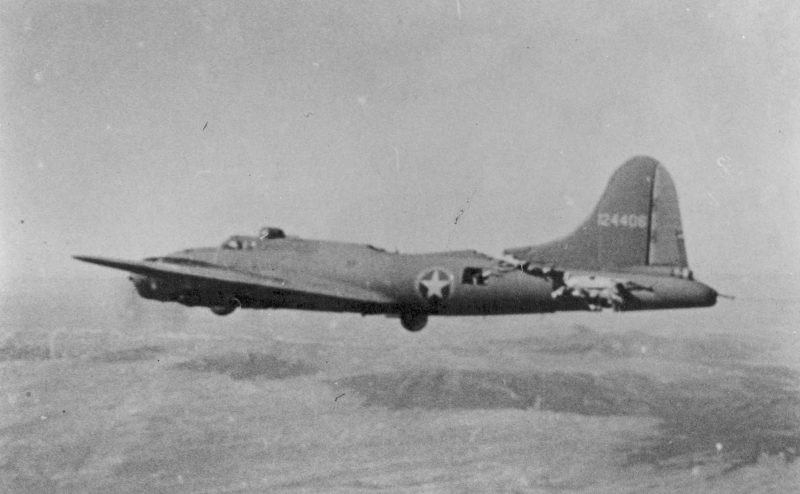
On New Year’s Eve 1944, the Germans who looked up saw a “secret weapon” flying over their heads. It was an enemy plane, but the truth was more amazing than everyone expected. Pilot Glenn Rojohn and his co-pilot Bill Leek had just made a flight over Hamburg. On the way home they came across a Messersmitt ME-109. The B-17 got in trouble. Below the B-17 flew another B-17 controlled by Bill McNab and Nelson Vaughn. No one knows what exactly happened, but the two planes touched each other and stuck together. The upper dome of McNab went through the bottom of Rojohn’s B-17. The gun dome at the bottom of the B-17 of Rojohn came through the top of the B-17 of Leek. With the bottom B-17 on fire, there was a catastrophe in the making. Because it failed to pull up the top B-17, Rojohn and Leek were forced to fly back across enemy territory together. Rojon gave orders to jump, but Leek didn’t want to abandon his captain. When they hit the ground, the bottom B-17 burst apart. McNab and Vaughn did not survive the crash, but Rojohn and Leek survived the blow. Four crew members survived the blow as well, 2 members did not.
Crippled B-17 home escorted by German Me-109

The B-17 of Charlie Brown “Y Olde Pub” flew with his crew a first mission to Bremen. Bremen was defended by a large contingent of fighter planes and flak. Brown’s B-17 occupied the dangerous left flank of the formation (Purple Hart Corner). The left wing of the aircraft was soon hit by heavy flak. One engine had to be turned off so that the aircraft had to leave the formation.
Soon they received a visit from a number of fighter planes. Some were knocked out by the board shooters, but the remaining fighter planes shot the tail of the B-17 into gruzus elements. The tail shooter Hugh “Ecky” Eckenrode died and nine crew members were injured.
All systems on board the B-17 were damaged. Brown himself was injured in the shoulder. Lack of oxygen and his wounds caused a temporary blackout and the B-17 ended up in a spiral towards earth. Just above the ground, Brown came back to and managed to straighten the bomber again. He no longer saw German hunters. They obviously assumed that the target had been destroyed.
When Brown, on his way home, passed a German airport, he was noticed by Franz Stigler, a German Me-109 ace. Stigler had to destroy one more bomber to qualify for the Ritterkreuz. Stigler immediately ascended and observed the bomber and did not detect any movement of the cannons. He saw that the bomber had been riddled with bullets and assumed that the crew had to be seriously injured. At some risk, Stigler manoeuvred his aircraft alongside the B-17. Stigler and Brown looked at each other and Brown fervently hoped the nightmare would soon be over.
Instead of giving the B-17 the blow, Stigler first escorted the bomber over land and another piece across the North Sea. He returned in time and gave Brown a salute. Brown was able to ground the B-17 in England.
40 years later, after a long career in the United States, Brown found out that Stigler had moved to Canada. Brown was keen to find the German pilot who had saved him and his crew from a wise death. He wrote to German pilots newsletters and eventually he got a reply from the pilot who spared his life.
After a long phone call, Stigler told Brown some of the details Brown had eluded. The two eventually met and have remained friends ever since.
The plane that landed it self
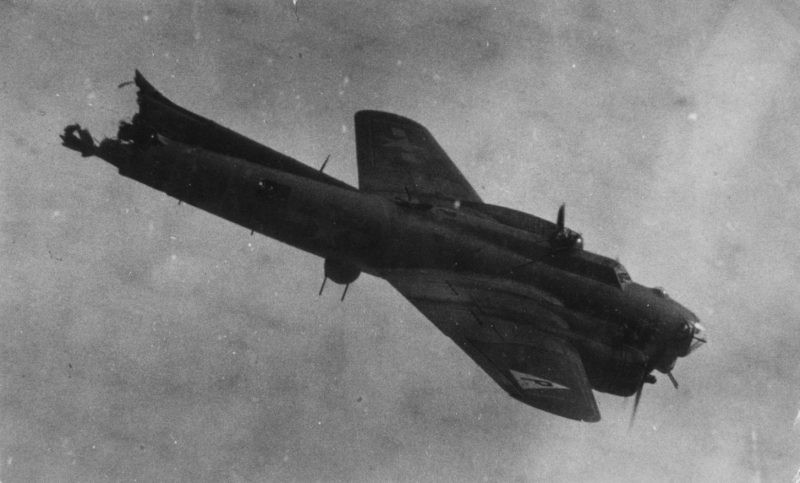
On 23 November 1944, a B-17 approached an RAF anti-aircraft unit in Belgium. The B-17 approached at high speed, the landing gear down. The unit’s staff were not aware of a planned landing, so one assumed an emergency and responded accordingly. The B-17 carried out the emergency landing and plowed into an adjacent field. The landing was so fast and uncontrolled that the propellers broke off and both wings smashed into the ground. Three engines continued to run and the base’s staff expected a badly injured crew to get out of the plane. 15 Minutes long nothing happened at all and after 20 minutes John Crisp gently approached the B-17, opened a hatch and went in: “The most remarkable find I did was about twelve parachutes, ready to use. But where was the crew? On the table of the navigator was the codebook with the colors and letters of that day for identification purposes. Several leather flight jackets were in the hull along with a number of chocolate bars. Amazing, but the crew was not present at all. The last comment in the codebook was “bad flak “.”
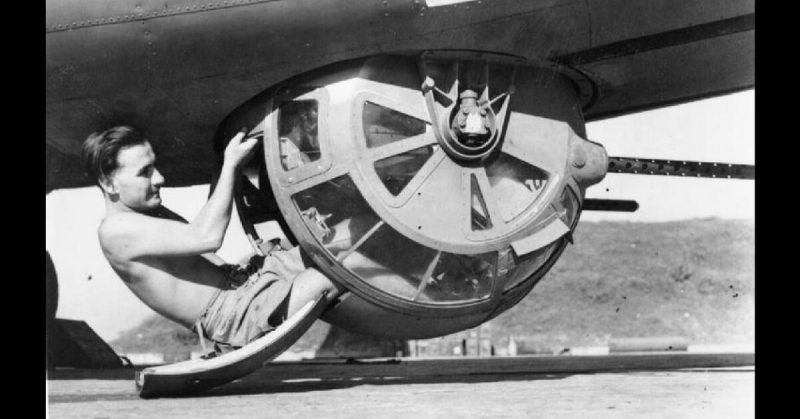
This B-17 became known as the “Phantom Fortress” and it took some time to find out exactly what had happened. The last mission was to bomb oil refineries at Merseburg. The crew, strangely enough, was found alive and well in Belgium. According to them, the bomb rack had shown cures and when they flew out of the formation to solve the problem, they were intercepted by enemy fighter planes and one of the engines caught fire. The crew decided to try to reach England, but when it became clear that the B-17 would not make it, the course was set for Brussels in Belgium. All unnecessary cargo was put overboard, but it continued to be tormented to keep the plane in the air. So the pilot put the B-17 on autopilot and ordered the plane to be abandoned.
The story of the crew did not match the facts. Several theories came on the table, but they could not explain why all parachutes were still on board. Also, it could not be explained how the B-17 could have landed at the right speed and drop angle.
Many theories and very few answers surround the landing of the “Phantom Fortress”. The unmanned landing remains one of the strangest and mysterious things that happened during the war.
Miss Donna Mae II

The B-17 Miss Donna Mae II fell out of position as she flew over the target, under another B17, Trudy. Bombs from the Trudy ripped off the left horizontal stabilizer of the device causing Miss Donna Mae II to hit in an unrecoverable spider. One of the wings was ripped off at 13,000 feet. All 11 crew members were killed. The aircraft smashed into the Oderbergstrasse in Berlin on 19 May 1944.
All in all, the B-17 was a very strong aircraft. Even with major damage, the B-17 was able to keep flying. The damage in photo 5 was too much for the B-17.
Nowadays there are still a small number of B-17s left, restored to show model or made ready for fly.

On October 2, 2019, the B-17 “Nine-o-Nine”, owned by the Collins foundation, crashed on Bradley International in America. The aircraft had previously been involved in accidents in 1987, when it shot through on the runway and in 1995 when there were problems with the landing gear. The pilot had already reported problems with engine number 4 at the start, but still went up with 10 passengers. Soon the pilot reported serious problems with engine number 4 and returned immediately. During the landing it went very wrong and the plane boarded in a building, resulting in 7 deaths, including the pilot and the co-pilot, plus someone on the ground. Research by the NTSB showed that the left magneto of engine number 4 was switched off and the right magneto on most cylinders hardly gave a spark. Furthermore, there were problems with the spark plugs for all engines. In addition, when landing, the propellers of engine number 3 were almost in neutral, number 4 were fully in neutral and the landing flaps had been withdrawn.
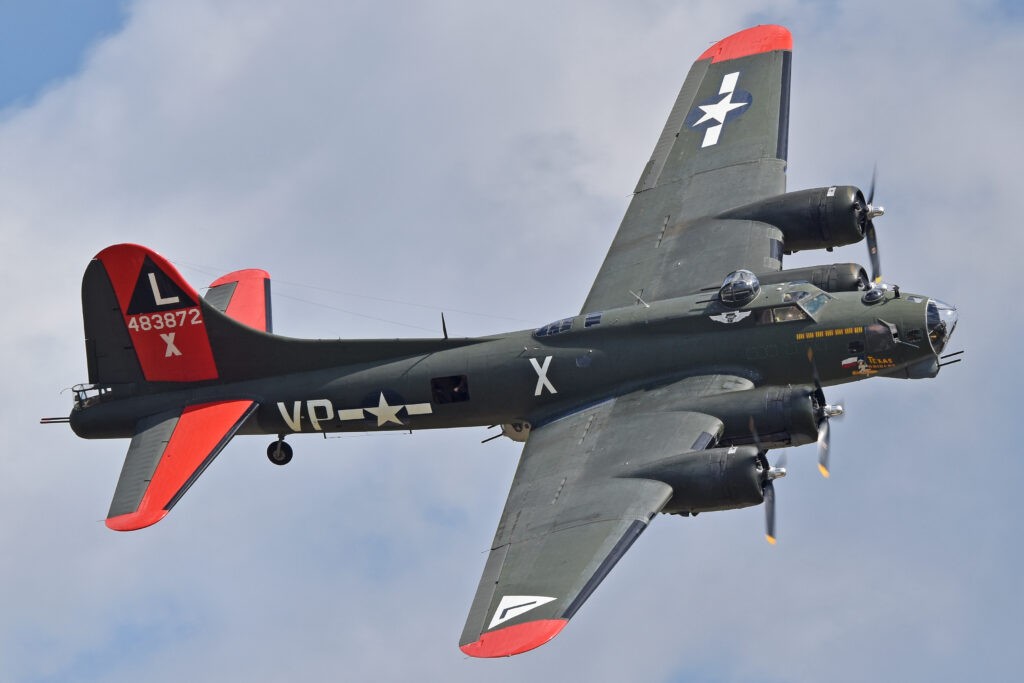
On November 12, 2022, a B17 “Texas Raiders” and a P63 King Cobra crashed at an airshow in Dallas. Both aircraft were in perfect condition. The larger aircraft, such as the B-17, flew in a large circle. The smaller aircraft, such as the Mustang and the King Cobra followed in a parallel circle on the inside of the circle of the larger aircraft. The King Cobra went out of formation and came out of the inner circle at too high a speed to retake his position in the formation. From the cockpit of the King Cobra, the B-17 was not visible and the King Cobra rammed the B-17 from above, with the result that both aircraft came down in chunks and crashed. All the occupants were killed.
Recording made a second before the collision. The King Cobra ended up between the wing and the tail plane of the B17. A second later, both aircraft fell down in pieces
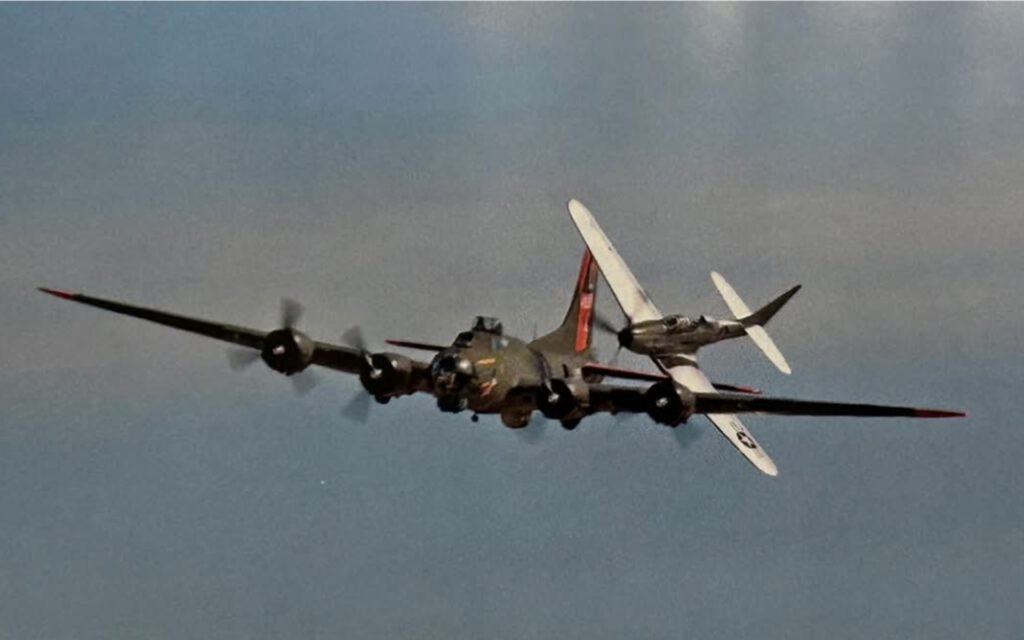

Source: Various War History Online articles and Wikipedia information.